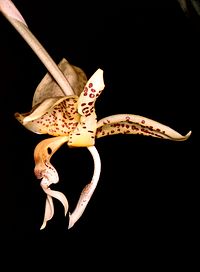Stanhopea oculata
| Stanhopea oculata subsp. var. | ||||||||||||||||||||||||||||||||||||||||||||||||||||||||
|---|---|---|---|---|---|---|---|---|---|---|---|---|---|---|---|---|---|---|---|---|---|---|---|---|---|---|---|---|---|---|---|---|---|---|---|---|---|---|---|---|---|---|---|---|---|---|---|---|---|---|---|---|---|---|---|---|

|
|
| ||||||||||||||||||||||||||||||||||||||||||||||||||||||
| ||||||||||||||||||||||||||||||||||||||||||||||||||||||||
Stanhopea oculata is a species of orchid occurring from Mexico to Colombia and southeastern Brazil.
| Standard Cyclopedia of Horticulture |
|---|
|
Stanhopea oculata, Lindl. (S. guttulata, C. Koch). Fig. 3676. Lvs. ovate, with a blade 1 ft. long: scape 1 ft. long, clothed with scarious pale brown sheaths, 3-6-fld.: fls. 5 in. across, very fragrant, pale yellow, thickly spotted with purple; sepals 3 in. long, reflexed; petals half as large; hypochil narrow, white, spotted with crimson and having 2 large dark brown spots near the base. Mex. (as Ceratochilus oculatus).—There are several varieties, differing in color and markings. Fig. 3676 is from an article by Safford on "Sacred Flowers of the Aztecs," named "the serpent-head orchid," in The Volta Review. CH
|
| Standard Cyclopedia of Horticulture |
|---|
|
Per GRIN, following is also S. oculata: Stanhopea bucephalus, Lindl. (S. grandiflora, Reichb. f.). Pseudobulbs crowded, rugose: lvs. petioled, 9 in. long, pointed: the pendulous raceme bearing 4-6 large, tawny orange fls. marked with large crimson spots; sepals and petals reflexed, the former broad; lower part of the labellum curved, boat-shaped, bearing 2 curved horns and a broad fleshy middle lobe; column green and white, spotted with purple. Aug. Mex., Peru.—Fls. very fragrant. Distinguished by its very short ovaries. CH
|
Cultivation
Propagation
Pests and diseases
Varieties
Gallery
References
External links
- w:Stanhopea oculata. Some of the material on this page may be from Wikipedia, under the Creative Commons license.
- Stanhopea oculata QR Code (Size 50, 100, 200, 500)
